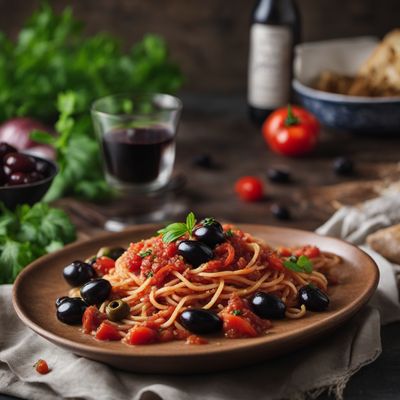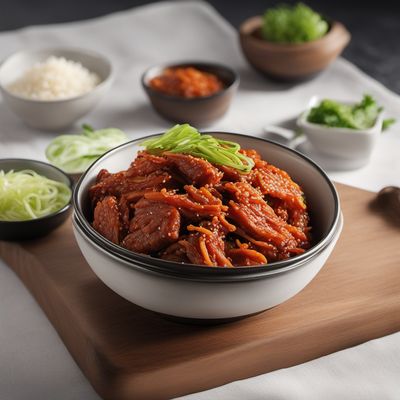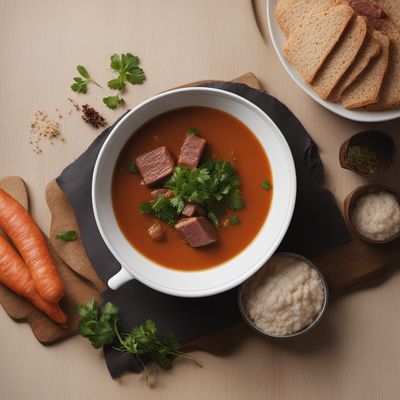
Ingredient
German salami
The Art of Craftsmanship: Exploring the World of German Salami
German salami is a dry-cured sausage made from a blend of finely ground pork, beef, or veal, seasoned with a combination of spices such as garlic, black pepper, and caraway seeds. It is characterized by its firm texture, deep red color, and a complex flavor profile that balances the richness of the meat with the aromatic spices.
Origins and history
The tradition of making salami in Germany dates back centuries, with each region boasting its own unique recipes and techniques. German salami has become synonymous with quality and craftsmanship, reflecting the country's dedication to preserving traditional charcuterie methods. It is often enjoyed as part of a hearty German breakfast or as a flavorful addition to sandwiches and charcuterie boards.
Nutritional information
German salami is a good source of protein and essential vitamins and minerals, including iron and vitamin B12. However, it is also high in sodium and saturated fat, so it should be consumed in moderation as part of a balanced diet.
Allergens
Pork is a common allergen associated with German salami, so individuals with pork allergies should avoid consuming this sausage. Additionally, some varieties of German salami may contain other allergens such as milk or gluten, so it is important to read the ingredient labels carefully.
How to select
When selecting German salami, look for products made by reputable producers known for their quality craftsmanship. Opt for salami that is firm to the touch, with a deep red color and a well-distributed marbling of fat. Avoid any salami with an off-putting odor or signs of mold.
Storage recommendations
To maintain the freshness and flavor of German salami, store it in a cool, dry place away from direct sunlight. Once opened, wrap the salami tightly in wax paper or butcher paper and store it in the refrigerator. Properly stored, German salami can last for several weeks.
How to produce
German salami is typically produced by professional charcutiers using specialized equipment and techniques. However, adventurous home cooks can try their hand at making salami using traditional recipes and guidance from experienced charcuterie enthusiasts. It requires careful attention to hygiene, temperature, and humidity control to ensure a safe and successful outcome.
Preparation tips
German salami can be enjoyed in various ways. Slice it thinly and serve it on a charcuterie board alongside cheeses, olives, and crusty bread. It can also be used as a flavorful addition to sandwiches, pizzas, or pasta dishes. For a traditional German experience, pair it with a freshly baked pretzel and a dollop of mustard.
Culinary uses
German salami is commonly used in German cuisine, particularly in breakfast dishes such as cold cuts served with bread, butter, and cheese. It is also a popular ingredient in sandwiches, salads, and charcuterie boards. Its robust flavor and firm texture make it a versatile addition to various dishes.
Availability
German salami is widely available in Germany and other European countries. It can also be found in specialty food stores or gourmet markets in other parts of the world. Additionally, it can be purchased online, offering accessibility to German salami enthusiasts worldwide.
More ingredients from this category
Recipes using German salami » Browse all

Bavarian-style Puttanesca with a Twist
Bavarian Delight: A Unique Twist on Puttanesca

Käsekrainer with a Korean Chinese Twist
Kimchi-infused Käsekrainer: A Fusion of Austrian and Korean Chinese Flavors

Palatine Panackelty
Savory Palatine Stew: A Hearty Delight from the Region

Palatine Toast
Palatine Delight: A Toasty Twist on Traditional German Cuisine

Zungenwurst with a Mariana Islands Twist
Savory Island-Inspired Zungenwurst Delight

Käsekrainer with Mustard Sauce
Cheesy Sausage Delight: Käsekrainer with Tangy Mustard Sauce

Liechtensteiner Zōni Soup
Hearty Liechtensteiner Zōni Soup: A Fusion of Japanese and Alpine Flavors

Bavarian-Style Ramen
Bavarian Ramen: A Fusion of Japanese and German Flavors

German-inspired Gourmet Hot Dog
Sausage Symphony: A German Twist on the Classic Hot Dog

Bavarian Lentil Soup
Hearty Lentil Delight: Bavarian Twist on a Classic Soup

Bavarian-Style Pizza
Bavarian Delight Pizza

Bavarian Eggs Benedict
Bavarian Delight: Traditional Eggs Benedict with a Bavarian Twist